Arterial hemodynamics - Study guides, Class notes & Summaries
Looking for the best study guides, study notes and summaries about Arterial hemodynamics? On this page you'll find 545 study documents about Arterial hemodynamics.
Page 2 out of 545 results
Sort by
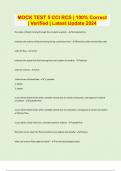
-
MOCK TEST 5 CCI RCS | 100% Correct | Verified | Latest Update 2024 | 20 Pages
- Exam (elaborations) • 20 pages • 2023
-
- $15.49
- + learn more
the study of blood moving through the circulatory system - hemodynamics indicates the volume of blood moving during a particular time - flow (also called volume flow rate) units for flow - L/min indicates the speed of a fluid moving from one location to another - velocity units for velocity - cm/s 3 basic forms of blood flow - 1. pulsatile 2. phasic 3. steady occurs when blood moves with a variable velocity due to cardiac contraction, and appears in arterial circulation - pulsatile flow...
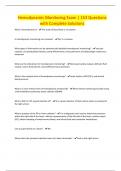
-
Hemodynamic Monitoring Exam | 153 Questions with Complete Solutions
- Exam (elaborations) • 14 pages • 2024
- Available in package deal
-
- $12.74
- + learn more
What is hemodynamics? - The study of blood flow or circulation Is hemodynamic monitoring non-invasive? - No, it is invasive. What types of information can be obtained with bedside hemodynamic monitoring? - vascular capacity, circulating blood volume, pump effectiveness, tissue perfusion, and physiologic response to treatment What are the indications for hemodynamic monitoring? - Decreased cardiac output, deficient fluid volume, excess fluid volume, and ineffective tissue perfusion What is...
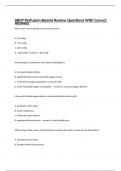
-
ABCP Perfusion Boards Review Questions With Correct Answers
- Exam (elaborations) • 14 pages • 2024
-
- $11.49
- + learn more
What is the max acceptable venous line pressure? A. 40 mmHg B. -40 mmHg C. 120 mmHg D. -120 mmHg - Answer B. -40 mmHg An advantage of continuous warm blood cardioplegia is: A. increased oxygen delivery. B. significantly decreased myocardial oxygen tension. C. a shift of the oxygen dissociation curve to the left. D. lower myocardial oxygen consumption. - Answer A. increased oxygen delivery. Intra-aortic balloon augmentation is contraindicated in patients with: A. prosthet...
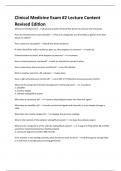
-
Clinical Medicine Exam #2 Lecture Content Revised Edition
- Exam (elaborations) • 22 pages • 2024
-
- $10.99
- + learn more
What are hemodynamics? - >>physical principles of blood flow based on pressure and resistance How are hemodynamics used clinically? - >>they are a diagnostic tool that helps us gather more data about our patient How is pressure calculated? - >>blood flow times resistance If either blood flow and/or resistance goes up, what happens to pressure? - >>it goes up If blood volume increases, what happens to pressure? - >>it increases How is arterial pressure monitor...
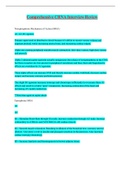
-
Comprehensive CRNA Interview Review Accurate responses are given.
- Presentation • 70 pages • 2023
-
- $18.99
- 3x sold
- + learn more
Comprehensive CRNA Interview Review Accurate responses are given. Comprehensive CRNA Interview Review Norepinephrine Mechanism of Action (MOA) A1, A2, B1 agonist. Primary agent used in distributive shock because it's ability to recruit venous volume and augment preload, while increasing arterial tone, and increasing cardiac output. Alpha one causing peripheral smooth muscle contraction. (low dose venous, high dose venous and arterial). Alpha 2 adrenoreceptor agonism actually ant...
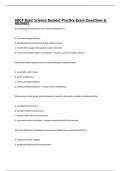
-
ABCP Basic Science Booklet Practice Exam Questions & Answers
- Exam (elaborations) • 7 pages • 2024
-
- $9.99
- + learn more
An advantage of continuous warm blood cardioplegia is: A. Increased oxygen delivery B. Significantly decreased myocardial oxygen tension. C. A shift of the oxygen dissociation curve to the left. D. Lower myocardial oxygen consumption - Answer increased oxygen delivery Intra-aortic ballon augmentation is contraindicated in patients with: A. prosthetic aortic valves B. aortic insufficiency C. ventricular septal defects D. peripheral atherosclerosis - Answer aortic insufficiency W...
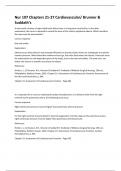
-
Nur 107 Chapters 21-27 Cardiovascular/ Brunner & Suddath’s Latest Solution(Score A+)
- Exam (elaborations) • 45 pages • 2024
-
- $12.49
- + learn more
A client with a history of right-sided heart failure lives in a long-term care facility. In the daily assessment, the nurse is required to record the level of this client's peripheral edema. Which would be the main area for examination? Correct response: feet and ankles Explanation: Edema occurs when blood is not pumped efficiently or plasma protein levels are inadequate to maintain osmotic pressure. When blood has nowhere else to go, the extra fluid enters the tissues. Particular areas ...
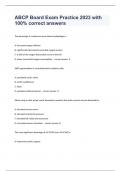
-
ABCP Board Exam Practice 2023 with 100% correct answers
- Exam (elaborations) • 58 pages • 2023
-
- $15.49
- + learn more
The advantage of continuous warm blood cardioplegia is: A: increased oxygen delivery B: significantly decreased myocardial oxygen tension C: a shift of the oxygen dissociation curve to the left D: lower myocardial oxygen consumption - correct answer A IABP augmentation is contraindicated in patients with: A: prosthetic aortic valves B: aortic insufficiency C: VSDs D: peripheral atherosclerosis - correct answer B When using a roller pump. aortic dissection caused by the aort...
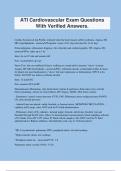
-
ATI Cardiovascular Exam Questions With Verified Answers.
- Exam (elaborations) • 17 pages • 2024
- Available in package deal
-
- $12.49
- + learn more
ATI Cardiovascular Exam Questions With Verified Answers. Cardiac Enzymes & Lip Profile- released when the heart muscle suffers ischemia- Angina, MI, HD, hyperlipidemia - answerTroponin- (norm <0.2) stays elevated for 14-21 days Echocardiogram- ultrasound- diagnose valve disorder and cardiomyopathy- HF, Angina, MI - answerPre- takes up to 1 hr Intra- lie on LT side and remain still Post- results/follow up care Stress Test- info on workload of heart- walking on a tread mill to increase ...
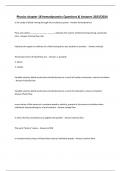
-
Physics chapter 18 hemodynamics Questions & Answers 2023/2024
- Exam (elaborations) • 6 pages • 2023
-
- $12.99
- + learn more
Physics chapter 18 hemodynamics Questions & Answers 2023/2024 is the study of blood moving through the circulatory system - Answer-hemodynamics Flow, also called ________ _______ ______, indicates the volume of blood moving during a particular time - Answer-Volume flow rate Indicates the speed or swiftness of a fluid moving from one location to another. - Answer-velocity Three basic forms of blood flow are: - Answer-1. pulsatile 2. phasic 3. steady Variable velocity, blood accelerates a...

How did he do that? By selling his study resources on Stuvia. Try it yourself! Discover all about earning on Stuvia


